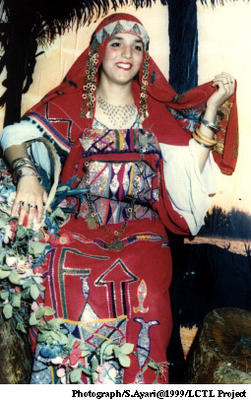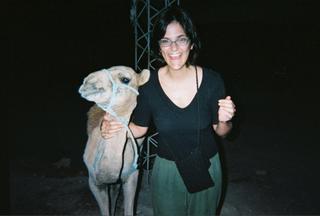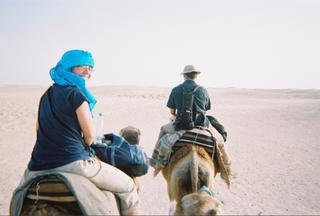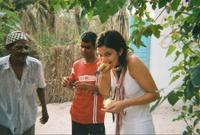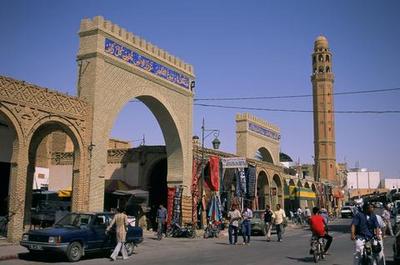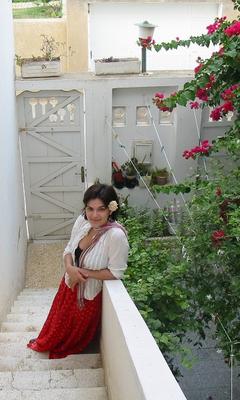So, while we were in
Touzer we thought it would be cool to get a ride out to the desert to watch the sunset from the sand dunes, something recommended by both
The Rough Guide and
The Lonely Planet.
Actually, I'm pretty sure they recommend you get a ride in a four-by-four. But we were operating on a budget and coordinated our ride through a guy who knew a guy with a Honda. For future reference, don't do this. Especially not in May-September, which is the season of sandstorms.

We followed the highway out almost to the Algerian border, and turned off on a rough road. At the time, I thought it was hard-packed sand. But in retrospect it was probably a paved road with a good amount of sand already blown over it.
As our little Honda rumbled out toward a little shanty in the distance surrounded by a bunch of camels, I joked to
my traveling companions, "How often do you think a car like this just gets stuck in the desert?" At the time, we all had a good laugh.
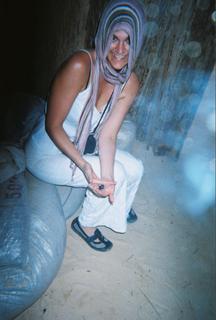
When we got out to the shanty, we piled out of the car and were struck full-force with flying sand. The wind was up. We clamored into the shanty to wait out the gusts along with the guys who earn a living selling camel rides to tourists. We were assured the wind would die down in about ten minutes or so.
While we waited we practiced our Arabic with the camel guides, seated comfortably on stacks of camel feed, getting up close and personal with the dung beetles (from the camels). Even inside the shelter, a fine layer of sand was settling in the hair on our arms, the folds of our clothes, and in our eyes and mouths. (Note, the scarf is wrapped around my head to keep the sand out of my eyes and mouth, not for cultural reasons.)
As it turns out, the sunset was nothing special. With so much sand in the air, you basically see a fuzzy ball of light dip to about 15 degrees above the horizon, then become indistiguishingable. It's not yet dark, but the horizon is so obscured by sand that you can't see the sun there.

After an hour or so, the guide seemed eager to load us back up in the car and get back. So we piled in, and headed back in the direction of the highway.
By this time, the road was buried under a significantly deeper pile of sand. In fact, it was almost impossible to tell where the road was. Gradually, we could feel the car slowing down ominously, drifting a little bit as if on a wet road, and then, it just stopped moving. Our guides suggested the car would move better with a little less weight. So we piled out and stood in the sandstorm as they tried again. But the wheels spun in vain.
Next they tried to dig beneath the tires down to the road below, but about six inches down it became obvious that we weren't on the road. After digging in a few other places, we figured out that the road was about four feet to the car's left.

Fortunately, we were still close enough to the camel hut that they could see our distress. A 4-by-4 full of tourists who had paid for the proper mode of traveling in the desert came by to try to pull us out.
A length of nylon rope was produced and stretched between the cars. The 4-by-4 pulled, our driver laid on the gas, and.... the rope snapped. The process was attempted again with the same result. At this point it occurred to us that our guide's car might be permanently stuck in the desert.
As a last-ditch effort, the two American girls hitched up our skirts, and along with Nic and our guide, pushed with all our might as the 4-by-4 pulled with its last bit of rope. Miraculously, the car started to shift. Then, it started to roll a bit, and we managed to push/pull it back to the road, where the car was once again able to travel on its own power. Hooray!
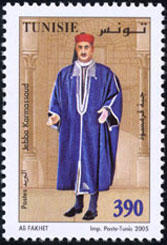 However, being functionally illiterate in Tunisia, I did have some trouble figuring out how much postage I needed to put on my letters. For several weeks I was sticking 1.300TD, or about one dollar, on my letters. It turns out the real rate is about half this, .700TD. Letters cost the same.
However, being functionally illiterate in Tunisia, I did have some trouble figuring out how much postage I needed to put on my letters. For several weeks I was sticking 1.300TD, or about one dollar, on my letters. It turns out the real rate is about half this, .700TD. Letters cost the same.